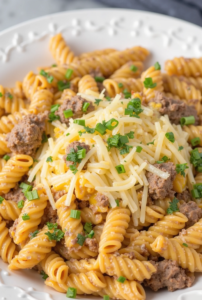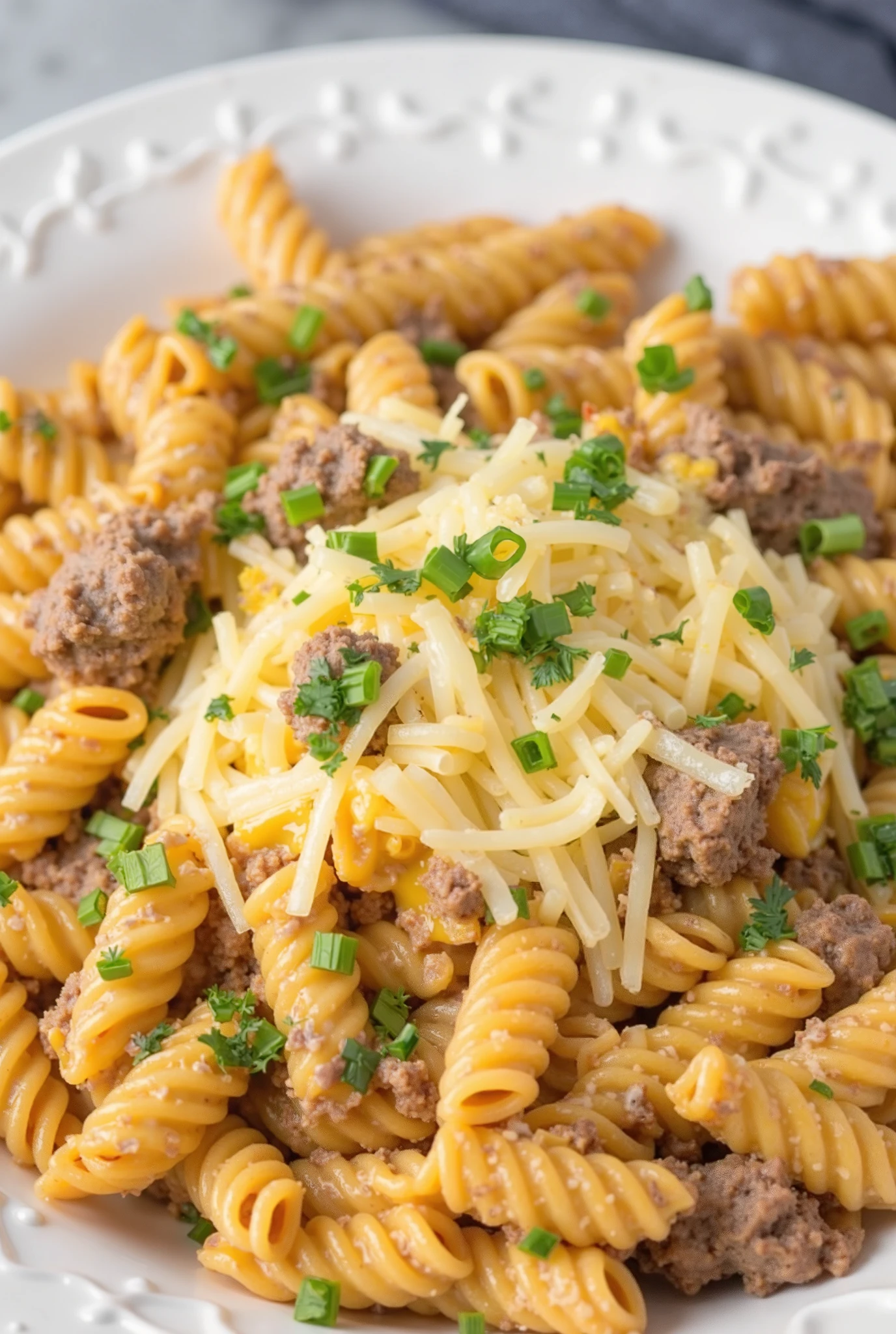Picture this: it’s Tuesday night, everyone’s hungry, and you’ve got exactly thirty minutes between soccer practice pickup and bedtime routines. You need something that’s going to satisfy the whole family without leaving you with a mountain of dishes. Enter this one-pot beef and cheddar ranch pasta – the kind of meal that makes you look like a dinner planning genius while secretly being ridiculously simple to pull off.
This isn’t just another pasta dish. It’s comfort food that happens in one pot, with flavors that hit all the right notes – savory ground beef, creamy ranch-seasoned sauce, sharp cheddar cheese, and perfectly cooked pasta that soaks up every bit of that deliciousness. Plus, the cleanup is a dream, which might actually be the best part of all.
Why One-Pot Meals Are Game Changers
Let’s talk about the real benefits of one-pot cooking beyond just fewer dishes to wash. When you cook pasta directly in the sauce, something magical happens – the starch from the pasta creates a naturally creamy, cohesive dish without needing heavy cream or complicated roux. The pasta absorbs the flavors as it cooks, creating depth that you simply can’t achieve when cooking components separately.
The ranch seasoning isn’t just an afterthought here – it’s doing heavy lifting as both a flavor enhancer and a thickening agent. Combined with the natural starch from the pasta and the richness of melted cheddar, you get a sauce that coats every piece of pasta without being heavy or overwhelming.
The Secret to Perfect One-Pot Pasta
The key to successful one-pot pasta lies in liquid ratios and timing. Too much liquid and you’ll end up with soupy pasta; too little and the pasta won’t cook properly. The magic number for this recipe is about 3 cups of liquid to 12 ounces of pasta, but you’ll adjust based on your pasta shape and how thick you want the final sauce.
Rotini or fusilli work beautifully here because their spirals grab onto the beef and sauce, but penne, shells, or even elbow macaroni will work just fine. The cooking happens in stages – brown the beef first to develop flavor, add aromatics, then liquid and pasta together so everything finishes at the same time.
Essential Ingredients and Smart Swaps
Main Components:
- 1 lb ground beef (80/20 fat ratio works best)
- 12 oz rotini or fusilli pasta
- 1 packet ranch dressing mix
- 3 cups beef broth
- 1 cup milk or half-and-half
- 2 cups sharp cheddar cheese, shredded
- 1 medium onion, diced
- 3 cloves garlic, minced
- 2 tbsp olive oil
- Salt and pepper to taste
- Fresh chives or parsley for garnish

Ingredient Flexibility
Ground beef can be swapped for ground turkey, chicken, or even plant-based meat alternatives. If you’re using leaner meat, add a tablespoon of olive oil to prevent sticking and add richness.
The ranch packet is convenient, but you can make your own blend with dried dill, garlic powder, onion powder, and dried parsley. For the liquid component, beef broth gives the richest flavor, but chicken broth or even vegetable broth work well. The milk can be anything from whole milk to heavy cream, depending on how rich you want the final dish.
Step-by-Step One-Pot Method
Building the Flavor Base
Start with a large, heavy-bottomed pot or Dutch oven – you’ll need the space and want even heat distribution. Heat olive oil over medium-high heat and brown the ground beef, breaking it up as it cooks. Don’t rush this step; getting good browning on the meat creates depth of flavor that carries through the entire dish.
Once the beef is browned, add diced onions and cook until softened, about 3-4 minutes. Add minced garlic and cook just until fragrant – about 30 seconds. This builds your aromatic base that will season the entire pot.
The Pasta Cooking Magic
Here’s where the one-pot method really shines. Add your beef broth, milk, and ranch seasoning packet to the pot, stirring to combine. Bring this to a boil, then add your pasta. The liquid should just barely cover the pasta – if it doesn’t, add a bit more broth or water.
Reduce heat to medium and cook, stirring occasionally, until the pasta is al dente according to package directions. The key here is stirring – it prevents sticking and helps the pasta cook evenly. As the pasta cooks, it releases starch that naturally thickens your sauce.
The Cheese Finish
Once the pasta is cooked and most of the liquid is absorbed, remove the pot from heat. This is crucial – adding cheese to a pot that’s still on the heat can cause it to seize and become grainy. Stir in the shredded cheddar gradually, allowing each addition to melt before adding more.
The residual heat from the pasta and pot will melt the cheese perfectly, creating a creamy, cohesive sauce that coats every piece of pasta. If the mixture seems too thick, add a splash of milk or broth. Too thin? Let it sit for a few minutes – the starch will continue to thicken it as it cools slightly.
Troubleshooting Common One-Pot Issues
Pasta sticking to the bottom: This usually means your heat is too high or you’re not stirring enough. Keep the heat at medium and stir every few minutes, especially in the first half of cooking.
Sauce too thin: Remove from heat and let it rest for 5 minutes. The starch will continue thickening. If still too thin, mix a tablespoon of cornstarch with cold milk and stir in.
Sauce too thick: Add warm milk or broth a tablespoon at a time until you reach desired consistency.
Cheese becomes grainy: This happens when cheese is added to a pot that’s too hot. Always remove from heat before adding cheese, and add it gradually.
Flavor Variations to Keep Dinner Interesting
Bacon Ranch Style: Cook 4-6 strips of bacon first, remove and crumble. Use the bacon fat to brown the beef, then add crumbled bacon back in with the cheese.
Spicy Southwest: Add a packet of taco seasoning along with the ranch, use pepper jack cheese instead of cheddar, and finish with diced jalapeños and cilantro.
Veggie-Loaded: Add frozen mixed vegetables or fresh broccoli florets in the last 5 minutes of pasta cooking. They’ll steam perfectly and add nutrition and color.
Italian-Inspired: Replace ranch with Italian seasoning, use mozzarella and parmesan instead of cheddar, and finish with fresh basil and diced tomatoes.
Make-Ahead and Meal Prep Strategies
While this dish is best served immediately, it does reheat reasonably well with a few tricks. Store leftovers in the refrigerator for up to 3 days. When reheating, add a splash of milk or broth to restore creaminess – the pasta continues absorbing liquid as it sits.
For meal prep, you can prep all your ingredients ahead of time. Brown the beef and dice the onions up to 2 days in advance. When you’re ready to cook, just dump everything in the pot and follow the cooking method.
This recipe also doubles easily if you’re feeding a crowd or want extra leftovers. Just make sure you have a large enough pot – you’ll need at least a 6-quart capacity for a double batch.
Kid-Friendly Appeal
There’s something about pasta mixed with ranch and cheese that speaks directly to kid taste buds. The flavors are familiar and comforting, without being too adventurous for picky eaters. The one-pot method also means everything is evenly distributed – no picking around vegetables or chunks of things they don’t recognize.
If you’ve got really picky eaters, you can easily customize individual portions. Serve some plain before adding final seasonings, or let kids add their own cheese and toppings. The base is mild enough that most kids will happily eat it.
The Economics of One-Pot Cooking
Let’s talk dollars and cents. This meal feeds 4-6 people generously for about $8-10 total, depending on local prices. Compare that to takeout or restaurant family meals, and you’re looking at significant savings. Plus, you control the quality of ingredients and can adjust sodium, fat, and other nutritional factors to your family’s needs.
The simplicity also saves time, which is valuable currency for busy families. From start to finish, including prep time, you’re looking at about 30 minutes. That’s faster than most delivery options and infinitely more satisfying.
Storage and Leftover Magic
Leftovers of this pasta are actually quite versatile. Cold portions make decent lunch salads with added fresh vegetables. You can also turn leftovers into a casserole by transferring to a baking dish, topping with more cheese, and baking until bubbly.
For longer storage, this freezes acceptably for up to 3 months, though the texture won’t be quite as creamy as fresh. Thaw overnight in the refrigerator and reheat gently with added liquid to restore consistency.
Perfect Pairings and Serving Suggestions
This rich, cheesy pasta benefits from simple, fresh accompaniments. A crisp green salad with vinaigrette cuts through the richness nicely. Steamed broccoli or green beans add color and nutrition without competing with the main flavors.
For a complete meal, serve with garlic bread or dinner rolls for extra comfort food appeal. The pasta is substantial enough to be the star, but these simple sides make it feel like a complete dinner experience.
Why This Recipe Works for Real Life
The beauty of this one-pot beef and cheddar ranch pasta lies in its reliability and flexibility. It’s the kind of recipe you can make on autopilot after a long day, but it’s also interesting enough that adults won’t feel like they’re eating “kid food.” The ranch flavor adds familiarity while the cheese creates richness, and the one-pot method means minimal cleanup.
It’s comfort food that doesn’t require planning ahead, shopping for specialty ingredients, or advanced cooking techniques. Sometimes the best family meals are the ones that feel effortless but taste like you put thought into them. This recipe delivers exactly that balance, making it the kind of dinner that everyone looks forward to and no one complains about cleaning up after.
Final Thoughts on Weeknight Success
One-pot beef and cheddar ranch pasta proves that satisfying family dinners don’t have to be complicated or time-consuming. With basic ingredients, simple techniques, and minimal cleanup, you can create something that feels indulgent and comforting while fitting into the reality of busy weeknight schedules.
The key is having realistic expectations – this isn’t fine dining, and it doesn’t need to be. It’s the kind of reliable, delicious meal that makes weeknight cooking feel manageable instead of overwhelming. Keep this recipe in your back pocket for those days when you need dinner to just work without any drama or stress.
